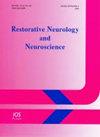Concussions in Boxers: Head Rotations and Neck Stiffness
IF 1.6
4区 医学
Q4 NEUROSCIENCES
引用次数: 0
Abstract
Background: The human head-and-neck has three degrees of rotational freedom – pitch, roll, and yaw. While the evolution of the head-and-neck mobility may have increased the overall fitness of homo sapiens, our head-and-neck mobility may have also introduced some differential vulnerability to injuries in impact-induced head rotations about the pitch, roll, and yaw axes. Methods and Findings: We examined impact-induced head rotations in boxing matches by analyzing videos. Our objective was to seek a quantitative relationship between impact-induced head kinematics and the knockout outcome. For each of the three rotational degrees of freedom, head angular velocities of impact-induced head rotations were significantly higher in knockout hits than in control hits without a knockout (p < 0.02). Knockout thresholds in pitch-roll-yaw measured as impact-induced head angular velocities were anisotropic with the lowest threshold in roll and became progressively higher in yaw and pitch, in that order. Regardless of the pitch-roll-yaw bearing, the velocities of the striking fists in knockout hits were not significantly higher than those in control hits. Conclusions: Accurate prediction of knockout via head kinematics was possible with pitch-roll-yaw information. Impact-induced head kinematics was strongly influenced by neck stiffness, making a case for the utility of reflexively increasing neck stiffness as an effective way to reduce impact-induced head rotations and concussion risk.拳击手的脑震荡:头部旋转和颈部僵硬
背景:人的头部和颈部有三个旋转自由度——俯仰、翻滚和偏航。虽然头颈活动的进化可能提高了智人的整体适应性,但我们的头颈活动也可能在撞击引起的头部俯仰、翻滚和偏转轴旋转中引入了一些不同的脆弱性。方法和发现:我们通过分析录像来研究拳击比赛中撞击引起的头部旋转。我们的目的是寻找撞击引起的头部运动学和击倒结果之间的定量关系。对于三个旋转自由度中的每一个,撞击引起的头部旋转的角速度在击倒命中明显高于没有击倒的对照命中(p < 0.02)。以撞击引起的头部角速度测量的俯仰-滚转偏航的击倒阈值是各向异性的,滚转阈值最低,偏航和俯仰阈值依次递增。在不考虑俯仰-滚转-偏航方位的情况下,击倒击球的击打速度并不显著高于控制击球。结论:利用俯仰-滚转-偏航信息,通过头部运动学准确预测击倒是可能的。撞击诱发的头部运动学受到颈部刚度的强烈影响,这使得反射性增加颈部刚度作为减少撞击诱发的头部旋转和脑震荡风险的有效方法的应用成为可能。
本文章由计算机程序翻译,如有差异,请以英文原文为准。
求助全文
约1分钟内获得全文
求助全文
来源期刊
CiteScore
5.40
自引率
3.60%
发文量
22
审稿时长
>12 weeks
期刊介绍:
This interdisciplinary journal publishes papers relating to the plasticity and response of the nervous system to accidental or experimental injuries and their interventions, transplantation, neurodegenerative disorders and experimental strategies to improve regeneration or functional recovery and rehabilitation. Experimental and clinical research papers adopting fresh conceptual approaches are encouraged. The overriding criteria for publication are novelty, significant experimental or clinical relevance and interest to a multidisciplinary audience. Experiments on un-anesthetized animals should conform with the standards for the use of laboratory animals as established by the Institute of Laboratory Animal Resources, US National Academy of Sciences. Experiments in which paralytic agents are used must be justified. Patient identity should be concealed. All manuscripts are sent out for blind peer review to editorial board members or outside reviewers. Restorative Neurology and Neuroscience is a member of Neuroscience Peer Review Consortium.

 求助内容:
求助内容: 应助结果提醒方式:
应助结果提醒方式:


